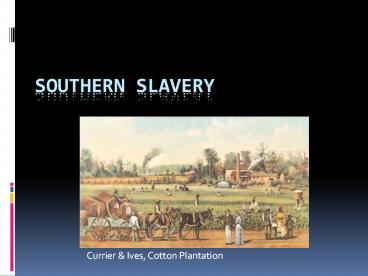Southern Slavery PowerPoint PPT Presentation
Title: Southern Slavery
1
Southern Slavery
- Currier Ives, Cotton Plantation
2
Growing Black Population
- 600 increase in black population, 1790-1860
- Less than 700,000 in 1790 4 million by 1860
- 1 out of every 3 Southerners majority in
Mississippi South Carolina - Mostly due to natural increase - only 50,000
smuggled in after 1808 - 260,000 free blacks by 1860 (6 of black
population) - Over 10 of all blacks free by 1810, but many
states forbade manumission in 1820s-1830s - Required to carry papers very limited in rights
- Could own slaves 3,200 did so
- Many were mulattoes
3
Population of the Southern States
4
Blacks in the North
- Northern states phased out slavery
- Penn. (1780), N.Y. (1799), Conn. N.J. (1804)
provided for gradual abolition almost all free
by 1840 - Mass. Supreme Court ruled slavery violated state
constitution in 1781 - Slavery barred from Northwest Territory (1787)
- Over 3/5 of Northern blacks lived in cities
- Most were unskilled laborers
- Only 5 states allowed black men to vote
5
The Rise of King Cotton
- Eli Whitneys cotton gin made it possible to
profitably grow short-staple cotton. - Annual production soared
- 1790 3,000 bales
- 1810 178,000 bales
- 1860 4 million bales
- By 1860, South grew 75 of worlds cotton.
Eli Whitneys Cotton Gin
6
The Cotton Kingdom
- Over ½ grown in Ala., Miss. La.
- ¾ grown by slaves
- 1 million slaves moved to new western
plantations, 1790-1860 - Mostly young adults
- 60-70 sold
- Equal sex ratio, except for sugar plantations
7
Plantation Profits
- Capitalist agriculture
- 8 annual return on investment, 1820-60
- Demand rose 5 annually
- Benefited rest of U.S.
- Cotton 60 of U.S. exports by 1840
- South became prime market for Northern
manufactured goods - Hampered economic development of South
- Few factories
- No public education
Main Plantation Crops
8
Slaveowning Concentrated in Wealthy Hands
- Only 26 of Southern white families owned slaves
by 1860 - Majority of slaveowners had 5 or fewer
- 2.7 owned 50 or more
- 0.1 owned 200 or more
- Average wealth of slaveowners was 13.9 times that
of non-slaveowners - Majority of slaves lived on middling or large
holdings - 25 on small holdings (1-9 slaves)
- 50 on middling holdings (10-49 slaves)
- 25 on large holdings (50 or more)
9
Plantation Life
- Supervision varied by size
- Resident masters supervised smaller plantations
(under 30 slaves) - Hired overseers ran larger ones
- Foremen (drivers) often slaves
- Lenient treatment mixed with harsh punishment
- Typical rations 1 peck of cornmeal 2.5-4 lb.s
of bacon per week 4 suits of clothing per year - Each family had small wooden cabin, cleaned
regularly to protect health - Sundays Saturday afternoons off
10
Slave Quarters, Carters Grove Plantation,
Virginia
11
Slave Quarters, Carters Grove Plantation,
Virginia
12
Life as a Slave
- Nuclear families with 7 children on average
- Masters encouraged monogamy to maintain order
- most escapees were young, unmarried men
- Economic imperatives took precedence, however
- 1/3 of all slave marriages broken up by sale of
spouses in Upper South - almost ½ of all children separated from at least
1 parent - Distinction between field slaves house slaves
real, but exaggerated - Field slaves (75) had more freedom but worse
conditions - House slaves (25) had better conditions but less
freedom
Picking cotton
13
The Paradox of Black - White Relations
- Dialectical relationship
- Each shaped the other
- Blacks contributed to broader American culture
while creating separate subculture - Whites could never resolve inherent
contradictions of slavery - Philosophical contradiction rests on assumption
that one man completely surrenders his will and
becomes an extension of another mans will - Legal contradiction slaves simultaneously people
property
Plantation near Richmond, VA
14
Justifications for Slavery
- Racism blacks seen as lazy childlike
- Argued slavery civilized Christianized them
- Argued only whipping would make slaves work
- Christian Religion
- Believed Bible condoned slavery
- Thought Curse of Ham (Gen. 920-27) justified
it - Feudal Myth
- claimed reciprocal relationship provided for
slaves needs in exchange for devoted service - Paternalistic care contrasted with inhumane
treatment of Northern factory workers
15
Woodcuts from Josiah Priest, In Defense of Slavery
16
Blacks View of Slavery
- Rejected racism, but learned to conform to
whites expectations to avoid punishment - Saw Christianity as affirming their equality
offering promise of earthly freedom as well as
heavenly redemption - Blacks neither grateful for care, nor considered
it payment viewed it as fundamental right - Used whites rhetoric of feudalism to demand
better treatment - Appreciated good masters accepted punishment
when deserved
Slave manacles
17
Extremely Unfavorable Conditions for Rebellion
- High ratio of whites to blacks, unlike rest of
the Americas - Small size dispersed nature of most
slaveholdings - Well-armed resident masters who kept close watch
on their property - Political stability (except during the
Revolutionary Civil Wars)
18
Running Away
- 50,000 slaves ran away each year
- 75 of escaped slaves were in teens or 20s
- Most returned to families or tried to pass as
free blacks in cities - Some went on strike to negotiate better
conditions
Underground Railroad map
19
Effects of Slavery on White Relationships
- All whites got benefits of being part of the
master race - Racism used to keep nonslaveholding white
majority in favor of system - All white men expected to ride slave patrols
- Concept of chivalry defined women as weak in
need of protection from rapacious black men - Women had to endure husbands raping of female
slaves - Women often biggest critics of slavery as a
result e.g. Sarah Angelina Grimke

